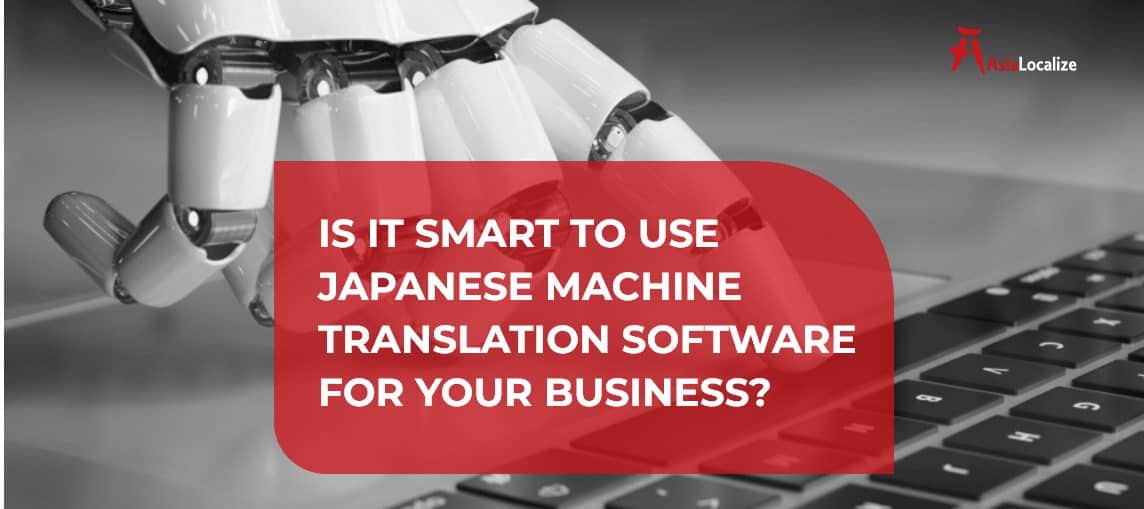
Is It Smart to Use Japanese Machine Translation Software for Your Business?
As one of the most complex languages in the world, many are questioning the Japanese machine translation software’s ability to deal with the intricacies that come with the job. Spoken by more than 127 million people, the Japanese language comes with a broad set of challenges, including the linguistic and cultural aspects, alongside the geographic diversity that necessitates tackling different Japanese dialects. So, can Japanese machine translation software provide the required quality and the highest levels of accuracy intended for business expansions? Does it suit your industry-specific requirements?From a technology depending solely on grammatical rules and language pair’s dictionaries to a sophisticated one, machine translation MT has evolved incredibly over the last few years. According to a study published by CSA Research, machine translation will be able soon enough to provide more accurate translations that look into the context, usage scenarios, and metadata because of the continuous development of artificial intelligence. But is MT worth your investment when expanding to the land of the rising sun?Here we’ll discuss machine translation and the ability to apply it in Japanese business translation projects. Can MT provide a reliable substitute for human translators? Is it suitable for all business industries? All of these and more will be discussed in our post.
Table of Contents
What is Machine Translation?
Machine Translation MT is the process of computer software translating a text from one language to another without the intervention of a human translator. In a matter of seconds, you will translate a large number of words into the desired language for free or at minimum costs. How? There are four types of machine translation engines:
- Rules-Based Machine Translation RBMT: the first-launched type of machine translation works based on grammatical rules and bilingual dictionaries customized according to the industry and topic, producing unreliable translations that need extensive work of human editing.
- Statistical Machine Translation SMT: A more advanced translation engine than RBMT, but it still has its issues. It analyzes a large amount of existing human translations and uses a statistical method in order to produce more reliable translations.
- Hybrid Machine Translation HMT: It’s a solution where RBMT and SMT merge. It’s where a translation memory is embedded to deliver consistent, more accurate translation services.
- Neural Machine Translation NMT: It’s the most developed of them all. It produces high-quality machine translation services depending on the continuous self-learning model using neural networks similar to the human brain’s neural system.
What are the Benefits of Using Japanese Machine Translation Software?
As mentioned above, at first, machine translation was launched with limited powers and then developed and still developing to get closer to human-like translation capabilities. Nowadays, many businesses use MT software as a stand-alone service or alongside machine translation post-editing services on their way to new markets. So, why is that? Here are the advantages of using Japanese machine translation software:
- Speed: Machine translation saves a lot of time for businesses. With a head-spinning speed, you will be able to translate millions of words into Japanese instead of waiting for hours and days while working with a Japanese translator.
Especially with high-volume Japanese translation projects, MT will help accelerate the whole process even when you request machine translation post-editing. - Cost-efficiency: MT doesn’t only save time but also money since it requires minimal human involvement. Whether you choose to rely totally on Japanese machine translation software or to have a Japanese post-editor’s help, it can be dramatically affordable.
- Streamlined Workflows: You can integrate some types of machine translation software with translation management systems, facilitating managing all related ongoing tasks simultaneously. From viewing, commenting, and linking actions to validating and editing, all of these and more can be done on the same platform.
- A Matter of Copy & Paste: MTs have been designed to ease the process of translating from or to any language, especially Latin languages. All you have to do is to copy any text and paste it into the box to get the Japanese-translated text in a matter of seconds.
Machine Translation vs. CAT Tools
It’s easy to confuse Machine Translation with Computer Aided Translation (CAT) tools. Here’s how to tell the difference.
Since they keep track of past translations, they generate corrections, industry-specific terms, and terminology based on translation memories to help niche translators produce more accurate and consistent translations in the fastest turnarounds. However, the results depend totally on the assigned translators’ experience, skills, and efforts.
CAT tools include translation memory, terminology management software, language search-engine software, grammar and spelling checkers, and more. Machine Translation: You can consider machine translation as your instantaneous translator; it’s a language translation tool that generates automated translations in seconds. It doesn’t produce consistent translations in tone, style, or terms, and the output may require the assistance of a human post editor. Anyone with a bit of technical background can use it without hard times.
There are many free or light-fee machine translation software, such as Google Translate, DeepL, Amazon Translate, and more.
WHAT ARE THE CHALLENGES OF USING JAPANESE MACHINE TRANSLATION SOFTWARE?
Let’s face the fact that machine translation can’t cater to all language pairs’ needs and requirements. It’s widely known that machine translation works best with Latin-based languages, such as English, French, German, and Spanish. On the contrary, any character-based language, such as Japanese, Chinese, and Korean, poses many challenges to be only dealt with through machine translation software. That’s the area where machine translation post-editing is most wanted.
And even with Latin-based languages, machine translation can’t be used as a substitute for human translation, because despite the MT improvements, it still doesn’t achieve 100% accuracy.


And here are some of the challenges of using Machine Translation Software in English and Japanese translations:
- Japanese Slang: Since many machine translation engines, such as Google Translate, depend on the existing online translations from the UN and other international organizations, it’s never too easy for a machine translation to deal with and handle Japanese slang words and phrases.
- Japanese Typographic Symbols: Some machine translation software can’t correctly translate the dot used to separate items’ components in a list and foreign names. For example, ??????? should be translated to banana and strawberry, but Google Translate leaves the dot as it is.
- Japanese Three-Alphabet System: A word like ???? is translated into English as “Service”. But actually, this word has a more detailed meaning than just service; a service provided in the house or given at a discounted price.
- Lost in Translations: Even the daily-used Japanese phrases could be mistranslated. ??????????, for instance, is translated into “Thank you” in English using the machine translation software, while it actually means the support we receive in a particular situation.



Instructions On How To Choose Your Japanese Machine Translation Software
AsiaLocalize shares some aspects you should consider before picking a machine translation software for your Japanese translation projects.
The Importance of Japanese Machine Translation Post-Editing Services for Business
Until now, it’s impossible to count 100% on machine translation software to get satisfactory Japanese translations for your business. Getting help from professional human translators is indispensable to getting a reliable outcome, especially with detail-oriented customers like the Japanese.And here comes the importance of machine translation post-editing services. They will provide you with a solution that combines the fast speed of machine translation and the highest levels of quality that won’t ever be accomplished without the help of a Japanese expert. However, if you choose to go the machine translation route without post-editing services, use it for unpublic, internal communications and purposes. In the end, machine translation makes economic sense and can be the ideal solution when dealing with a tight schedule. Still, it can’t be your ally in the Japanese business market as a stand-alone service. Merging machine translation with human translation and editing powers can meet your time and quality expectations and requirements and work wonders in the land of the rising sun.



Get our post-editing experts’ help and never let an error undetected.

